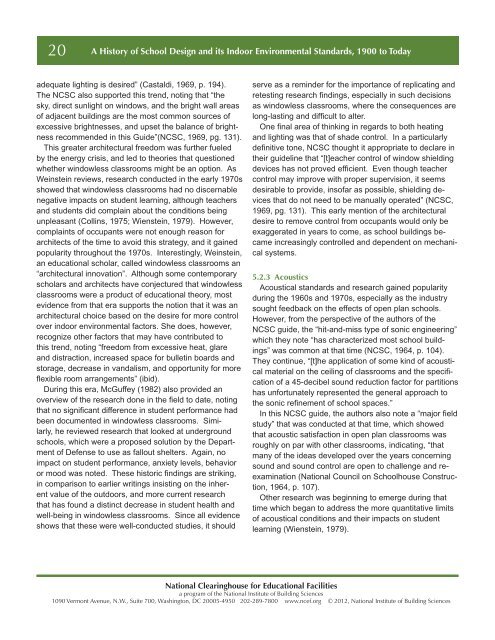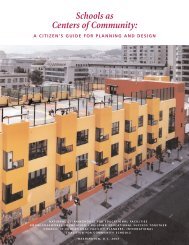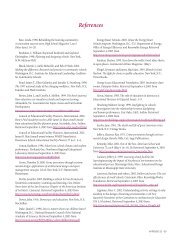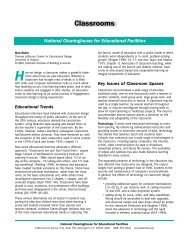A History of School Design and its Indoor - National Clearinghouse ...
A History of School Design and its Indoor - National Clearinghouse ...
A History of School Design and its Indoor - National Clearinghouse ...
Create successful ePaper yourself
Turn your PDF publications into a flip-book with our unique Google optimized e-Paper software.
20 A <strong>History</strong> <strong>of</strong> <strong>School</strong> <strong>Design</strong> <strong>and</strong> <strong>its</strong> <strong>Indoor</strong> Environmental St<strong>and</strong>ards, 1900 to Today<br />
adequate lighting is desired” (Castaldi, 1969, p. 194).<br />
The NCSC also supported this trend, noting that “the<br />
sky, direct sunlight on windows, <strong>and</strong> the bright wall areas<br />
<strong>of</strong> adjacent buildings are the most common sources <strong>of</strong><br />
excessive brightnesses, <strong>and</strong> upset the balance <strong>of</strong> brightness<br />
recommended in this Guide”(NCSC, 1969, pg. 131).<br />
This greater architectural freedom was further fueled<br />
by the energy crisis, <strong>and</strong> led to theories that questioned<br />
whether windowless classrooms might be an option. As<br />
Weinstein reviews, research conducted in the early 1970s<br />
showed that windowless classrooms had no discernable<br />
negative impacts on student learning, although teachers<br />
<strong>and</strong> students did complain about the conditions being<br />
unpleasant (Collins, 1975; Wienstein, 1979). However,<br />
complaints <strong>of</strong> occupants were not enough reason for<br />
architects <strong>of</strong> the time to avoid this strategy, <strong>and</strong> it gained<br />
popularity throughout the 1970s. Interestingly, Weinstein,<br />
an educational scholar, called windowless classrooms an<br />
“architectural innovation”. Although some contemporary<br />
scholars <strong>and</strong> architects have conjectured that windowless<br />
classrooms were a product <strong>of</strong> educational theory, most<br />
evidence from that era supports the notion that it was an<br />
architectural choice based on the desire for more control<br />
over indoor environmental factors. She does, however,<br />
recognize other factors that may have contributed to<br />
this trend, noting “freedom from excessive heat, glare<br />
<strong>and</strong> distraction, increased space for bulletin boards <strong>and</strong><br />
storage, decrease in v<strong>and</strong>alism, <strong>and</strong> opportunity for more<br />
fl exible room arrangements” (ibid).<br />
During this era, McGuffey (1982) also provided an<br />
overview <strong>of</strong> the research done in the fi eld to date, noting<br />
that no signifi cant difference in student performance had<br />
been documented in windowless classrooms. Similarly,<br />
he reviewed research that looked at underground<br />
schools, which were a proposed solution by the Department<br />
<strong>of</strong> Defense to use as fallout shelters. Again, no<br />
impact on student performance, anxiety levels, behavior<br />
or mood was noted. These historic fi ndings are striking,<br />
in comparison to earlier writings insisting on the inherent<br />
value <strong>of</strong> the outdoors, <strong>and</strong> more current research<br />
that has found a distinct decrease in student health <strong>and</strong><br />
well-being in windowless classrooms. Since all evidence<br />
shows that these were well-conducted studies, it should<br />
serve as a reminder for the importance <strong>of</strong> replicating <strong>and</strong><br />
retesting research fi ndings, especially in such decisions<br />
as windowless classrooms, where the consequences are<br />
long-lasting <strong>and</strong> diffi cult to alter.<br />
One fi nal area <strong>of</strong> thinking in regards to both heating<br />
<strong>and</strong> lighting was that <strong>of</strong> shade control. In a particularly<br />
defi nitive tone, NCSC thought it appropriate to declare in<br />
their guideline that “[t]eacher control <strong>of</strong> window shielding<br />
devices has not proved effi cient. Even though teacher<br />
control may improve with proper supervision, it seems<br />
desirable to provide, ins<strong>of</strong>ar as possible, shielding devices<br />
that do not need to be manually operated” (NCSC,<br />
1969, pg. 131). This early mention <strong>of</strong> the architectural<br />
desire to remove control from occupants would only be<br />
exaggerated in years to come, as school buildings became<br />
increasingly controlled <strong>and</strong> dependent on mechanical<br />
systems.<br />
5.2.3 Acoustics<br />
Acoustical st<strong>and</strong>ards <strong>and</strong> research gained popularity<br />
during the 1960s <strong>and</strong> 1970s, especially as the industry<br />
sought feedback on the effects <strong>of</strong> open plan schools.<br />
However, from the perspective <strong>of</strong> the authors <strong>of</strong> the<br />
NCSC guide, the “hit-<strong>and</strong>-miss type <strong>of</strong> sonic engineering”<br />
which they note “has characterized most school buildings”<br />
was common at that time (NCSC, 1964, p. 104).<br />
They continue, “[t]he application <strong>of</strong> some kind <strong>of</strong> acoustical<br />
material on the ceiling <strong>of</strong> classrooms <strong>and</strong> the specifi -<br />
cation <strong>of</strong> a 45-decibel sound reduction factor for partitions<br />
has unfortunately represented the general approach to<br />
the sonic refi nement <strong>of</strong> school spaces.”<br />
In this NCSC guide, the authors also note a “major fi eld<br />
study” that was conducted at that time, which showed<br />
that acoustic satisfaction in open plan classrooms was<br />
roughly on par with other classrooms, indicating, “that<br />
many <strong>of</strong> the ideas developed over the years concerning<br />
sound <strong>and</strong> sound control are open to challenge <strong>and</strong> reexamination<br />
(<strong>National</strong> Council on <strong>School</strong>house Construction,<br />
1964, p. 107).<br />
Other research was beginning to emerge during that<br />
time which began to address the more quantitative lim<strong>its</strong><br />
<strong>of</strong> acoustical conditions <strong>and</strong> their impacts on student<br />
learning (Wienstein, 1979).<br />
<strong>National</strong> <strong>Clearinghouse</strong> for Educational Facilities<br />
a program <strong>of</strong> the <strong>National</strong> Institute <strong>of</strong> Building Sciences<br />
1090 Vermont Avenue, N.W., Suite 700, Washington, DC 20005-4950 202-289-7800 www.ncef.org © 2012, <strong>National</strong> Institute <strong>of</strong> Building Sciences










